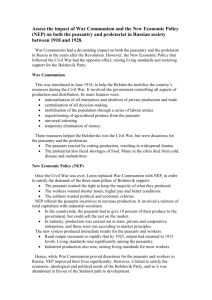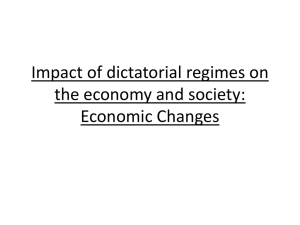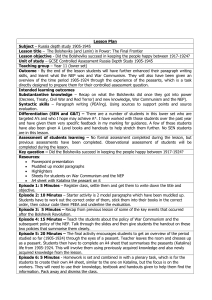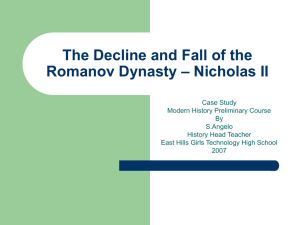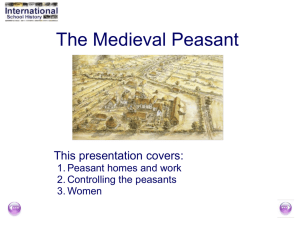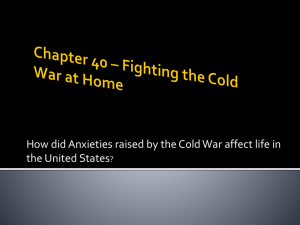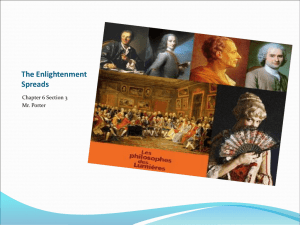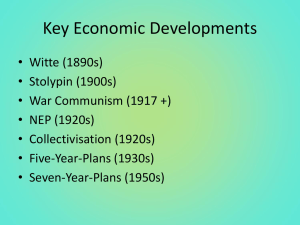New Economic Policy - Alness Academy History
advertisement
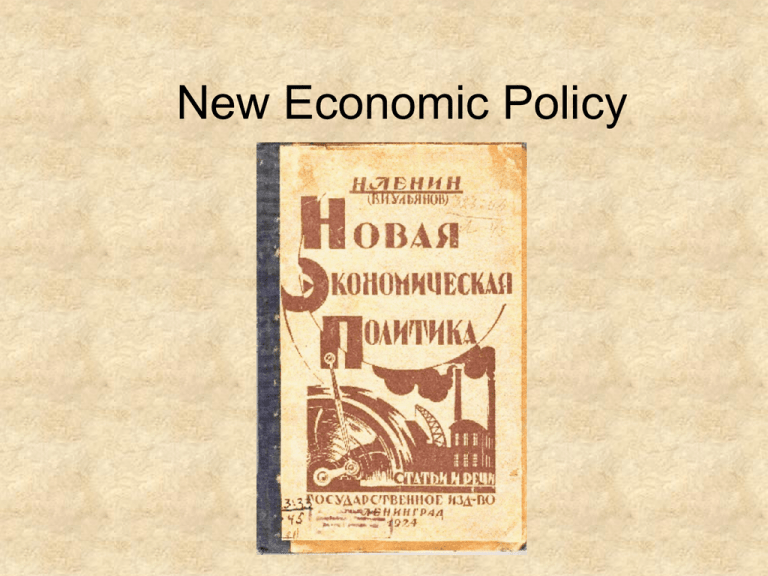
New Economic Policy War Communism To win the Civil War, the communists put together an army of 3 million men. This number of men could only be supplied by taking extreme measures, because the country had not yet recovered from the First World War. Lenin introduced a policy known as War Communism. This was a system that gave the communists direct control of all trade and industry. Civil War • The Civil War meant few factories were producing civilian goods • What was available was expensive • Russia suffered from soaring inflation • Money became almost worthless • Peasants did not want to accept money for their produce • Workers in towns had few possessions to exchange for food, so they soon began to go hungry. Requisition Squads • Communists sent out requisition squads of soldiers to take all “surplus” food without paying. • The ruthless policy provided some extra food for cities, but left the peasants angry. • The peasant cut the amount they produced so there would be no “surplus” to take • There was a terrible famine in 19211922 due to the peasants producing less and two poor harvests – about 5 million people died. Problems in the Cities • Workers were forced to work longer hours, under strict new laws which included the death penalty for strikes. • Rations were too small, or not available at all. • Some peasants brought food to sell, but the price of this black-market food was too high for most workers. • People caught trading for profit were shot. • Cities began to empty as workers returned to the countryside to find food. • Petrograd lost 70% of its inhabitants, and Moscow lost 50%. Growing opposition to War Communism • By early 1921 discontent with War Communism was at its height. • The Red Army stopped a number of rebellions in the countryside, costing them ¼ million men in one year. • If the communists were to survive they needed a policy to replace War Communism. • This new policy needed to strengthen the economy and end the rising discontent in the cities and the countryside. The New Economic Policy In 1921 Lenin introduced his New Economic Policy (NEP). This reduced the government’s control over the economy. Some people were allowed to work for themselves and make a profit, instead of working directly for the state. The new policy aimed to boost the economy and remove the opposition of the workers and peasants to communist rule by easing their problems. Results of NEP • End of Requisition squads • Small tax on food peasants produced • Peasants began to plan to produce more, and sell the surplus for profit. • Small-scale private businesses were allowed to get industry and trade moving • This led to a new class of small business men & traders called Nepman. • Opposition to the communists ended. Benefits of NEP • Year by year food production increased • Industry began to recover. • Value of money began to stabilise • Variety of goods on sale increased. • Majority of peasants lost interest in rebellion once the requisition squads stopped. • Fewer strikes in the cities. • NEP reduced discontent amongst workers and peasants. Criticism of the NEP • The new policy only restored industry and agriculture to pre-war production levels 80 Grain (Million tonnes) 70 60 Coal (million tonnes) 50 40 Steel (million tonnes) 30 20 10 0 1913 1921 1923 1925 1926 Average wage (per month in roubles) • Many communists resented the NEP because they thought it represented the return to capitalism. Success & Failure • NEP lasted to 1928 and generally Russia became wealthier. – An Anglo-Soviet trade agreement in 1921 increased trade with the West. • Peasants found prices of manufactured goods high – After 1925 were unwilling to sell their grain for money as they could not buy much with it. • Some peasants became quite rich buying land and animals, – BUT many remained poor and continued using backward methods of farming. • Industrial workers were better off – BUT levels of unemployment remained high, particularly among young people – high crime rate Many people angry about the profiteering of the Nepmen and the growth of a class of rich businessmen: • after 1925 steps were taken to curb their profits and luxurious lifestyle • Up to 1915 progress under NEP had been from very low levels of production and involved repairing and restoring old machinery, factories and transport. • But by 1926 the economy had reached pre-1914 levels and massive new investment was needed. • By the end of the 1920s food supplies were a problem again.
